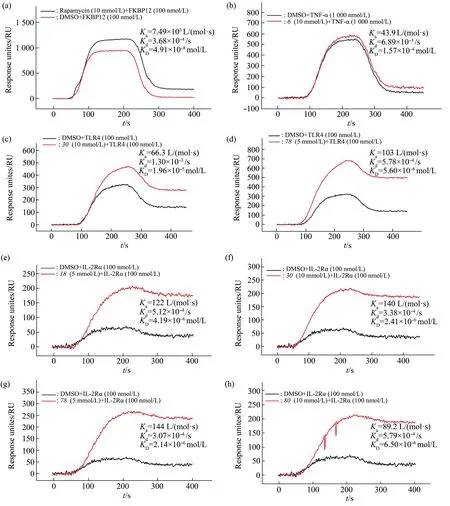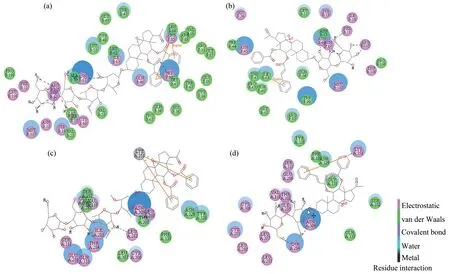Study,on,The,Interaction,of,Polyoxypregnane,Glycosides,From,Dregea,sinensis,With,Immune,Proteins*
时间:2023-02-14 16:20:09 来源:千叶帆 本文已影响人
WANG Zhi,SONG Juan,DAI Rong-Ji,DENG Yu-Lin,LÜFang**
(1)Beijing Key Laboratory for Separation and Analysis in Biomedicine and Pharmaceuticals,School of Life Science,Beijing Institute of Technology,Beijing 100081,China;2)Institute of Radiation Medicine,Academy of Millitary Medical Sciences of Academy of Millitary Science,Beijing 100850,China)
Abstract Objective Based on chemical structural characteristics,the bioactivity of polyoxypregnane glycosides from Dregea sinensis,and the molecular interaction between compounds and targeted proteins were investigated.Methods The bioactive screening of 191 polyoxypregnane glycosides(>800 u),and the kinetic evaluation on human immune-related proteins was carried out by molecular docking and SPR experiment.Results Seven compounds(6,18,23,30,78,79,and 80)and 3 immune-related proteins(IL-2Rα,TLR4,and TNF-α)were selected through virtual screening.Compounds 30 and 78 showed the significant binding tendency with IL-2Rα and TLR4 in SPR experiment,and KD values with IL-2Rα were 2.41×10-6 and 2.14×10-6 mol/L,meanwhile KD values with TLR4 were 1.96×10-5 and 5.60×10-6 mol/L,respectively.The interactions between targeted proteins and compounds were further characterized by discovery studio.The analysis of molecular docking revealed the binding pocket residues for SPRpositive molecules 6,18,30,78,and 80.Conclusion The result indicated these glycosides could bind to targeted proteins through forming hydrogen bonds and Pi-Pi interactions.The study is meaningful for bioactive evaluation of polyoxypregnane glycosides,and provides valuable exploration to the underlying mechanisms of effective compounds with low abundance.
Key words polyoxypregnane glycosides,immune inhibitors,molecular docking,surface plasmon resonance
Many diseases were in the closest relationship with immune regulation,such as infection,immunodeficiency disease,hypersensitive reaction and cancer[1].With the rapid development of drug research,medicinal plants as natural sources of effective immune inhibitors have been widely investigated[2],and more attention has been paid to the molecular interaction between natural products and targeted proteins[3-5].
In our previous studies,191 polyoxypregnane glycosides were idetified by nuclear magnetic resonance(NMR)and high-performance liquid chromatography coupled with multistage mass spectrometry(HPLC-MSn)methods[6-10]fromDregea sinensis,an important medicinal plant.Although modern pharmacological studies had reported that polyoxypregnane glycosides possessed various pharmacological effects including anti-tumor,anti-depression and immunomodulation[11-15],bioactive studies always remained at screening of crude extract due to the low amount of these compounds in the plant,and further work was rarely carried out.
We attempted to discover immunosuppressive compounds fromDregea sinensis,and forecasted the interaction between polyoxypregnane glycosides and immune-related proteins.The research strategy was proposed based on characteristics of chemical structures as following:(1)the construction of database including polyoxypregnane glycosides as ligands and immune-related proteins as target proteins;(2)the virtual screening to filter ligands and target proteins by molecule docking with Discovery Studio(DS);(3)the verification of interaction between selected ligands and selected target proteins by the analysis of surface plasmon resonance(SPR)and in silico.According to these strategy,191 polyoxypregnane glycosides were collected,and some important cytokines and receptors in immune regulation,e.g.interleukin-n(IL-n),interleukin-nR(IL-nR),tumor necrosis factor(TNF)and Toll-like receptors(TLRs)were chosen as target proteins[16-18].The top-rank polyoxypregnane glycosides interact with selected target proteins were shown in Figure 1 on the basis of Libdock scores and the orthogonal tests.

Fig.1 The structures of top-ranked polyoxypregnane glycosides
1.1 Chemicals and reagents
SH-(PEG)n-COOH(MW1 000),SH-(PEG)n-OH(MW 346)and gold coated slides(Plexera)were purchased from Yare biotech(Shanghai,China).EDC-HCL and NHS,DMAP were provided by Aladdin Chemistry.FKBP12(10268-H08E)was provided by Sino Biological Inc.(Beijing,China).Human recombinant TNF-α(ab155699)was provided by Abcam(Cambridge,UK).Human recombinant IL-2Rα(RPB837Hu01)and human recombinant TLR4(RPA753Hu01)were provide by Cloud-clone Corp.(Wuhan,China).Buffers and reagents were prepared using Milli Q water(Milipore,USA).
1.2 In silico screening of molecules and target proteins
Database of polyoxypregnane glycosides was constructed,and compounds1-81were colletcted from the references[9-10],compounds82-138were colletcted from the references[6,8],compounds139-191were colletcted from the references[7,19](Table S1),and 3D structures of all compounds were transferred by ChemBio Office software(Cambridge,UK).3D structures of target proteins were obtained from protein data bank(PDB,http://www.rcsb.org/pdb/home/home.do).The protein molecules were filtered by three criterias:(1)3D structures without mutation and missing residues around the active site;(2)3D structures were X-ray crystal structures with high resolution;(3)for protein structures with two chains or more,the chain around the active sites was reserved for docking(Table S2).
The ligands were structurally rearranged in response to the receptor in Discovery Studio 4.0(Accelrys,San Diego,USA).The interactions of human proteins and ligands were evaluated by molecular dock search algorithm[20],which hinted the target compounds as inhibitors of proteins(Table S3).The binding molecules were finally selected as the potential active compounds ofDregea sinensison the basis of their higher LibDock score(at least>100).
1.3 Surface plasmon resonance validation
Validate affinity measurements for binding of the small molecules to TNF-α,IL-2Rα and TLR4 were performed on a Plexera PlexArray HT system(Plexera LLC,Woodinville,WA,USA)using a bare gold SPRi chip(Nano-capture gold chips,with a gold layer of 47.5 nm thickness)[21].Briefly,proteins(100 nmol/L or 1 000 nmol/L in PBS buffer)were immobilized to the surface of a biochip Graft-to-thenfrom-COOHviaPDMS using the SpotBot3 Microarrayer system.Selected polyoxypregnane glycosides were dissolved in PBS buffer at a concentration of 5 mmol/L or 10 mmol/L.The interactions between target proteins and polyoxypregnane glycosides were determined by SPR imaging using the Plexera PlexArray HT system.Realtime binding signals were recorded and the binding data were analyzed using the PLEXERA SPR Date Analysis Module.Kais the association rate constant for the binding,Kdis the dissociation rate constant for the complex.Affinities were calculated,in the kinetic analysis,from the relationKD=Kd/Kain the equilibrium analysis.
1.4 Interaction analysis
CDOCKER module of DS was proposed for analyzing the interaction between selected polyoxypregnane glycosides and proteins,and it was in rigid condition:the receptors were held rigidly while the ligands were allowed to flex during the docking process.CDOCKER was an implementation of a CHARMm based docking tool[22-23].For each complex pose,the CHARMm energy(interaction energy plus ligand strain)and the interaction energy,which indicate ligand binding affinity,were calculated.The structures of identified hits were prepared and docked into the ligand-binding pocket of receptor.Different poses for each test molecule were generated and analyzed on the basis of CDOCKER interaction energy.
The virtual screening had played a guiding role in discovering bioactive molecules,and indicating the interaction between proteins and ligands[24-26].The intuitionistic diagram of interaction between ligand molecules and protein molecules was obtained by the computational methods.The possible binding domains of the proteins were defined from PDB site records.The orthogonal test of each ligand-receptor was done to confirm the best poses radius and active pocket site.
In the study,all proteins were ranked after docking with known immunomodulators(Table S4),e.g.cyclosporine A[27]as reference molecules in the primary LibDock process,which was intended to help selection of efficient binding site during the virtual screening.The analysis showed most proteins with binding tendency were immune-related.Combined with the results of cell model test[8,10],different PDB protein structures of 3 target proteins(Table S5)were selected for the second round virtual screening against 191 polyoxypregnane glycosides.A cut-off range of docking score had been set as a specific Libdockscores,that is higher than the related reference molecules.Screened ligand molecules were ranked on the basis of their docking score.
To exclude the probability of missing screen or false positives,SPR experiment of the glycosides6,18,23,30,78,79and80,isolated in our previous work and ranked in the top ten(Table S6),was carried out to 3 targeted proteins.As a result,compound6showed the binding affinity towards TNF-α withKDvalue 1.57×10-4mol/L.Compounds30and78showed the significant binding tendency with IL-2Rα and TLR4 in SPR experiment,andKDvalues with IL-2Rα were 2.41×10-6mol/L and 2.14×10-6mol/L,meanwhileKDvalues with TLR4 were 1.96×10-5mol/L and 5.60×10-6mol/L,respectively.In addition,compounds18and80showed the high binding affinity towards IL-2Rα,andKDvalues were 4.19×10-6mol/L and 6.50×10-6mol/L,respectively.The binding kinetics andKDof the candidate glycosides were showed in Figure 2.

Fig.2 Kinetic analysis of the binding of selected compounds to the putative targets using the PlexArray®HT instrument
In order to study ligand-protein binding mechanisms,compounds6,18,30,78,and80were further evaluated by CDOCKER module of DS.The CDOCKER interaction energy as an estimation of molecular complex binding affinity was applied in this procedure(Table S7).Based on the analysis of the interactions formed by ligands and IL-2Rα(2ERJ),compounds18,30,78and80mainly formed pairs of hydrogen bonds by the carbonyl-O of the structures with the amide-NH of ASN/ARG/TRP,and formed pairs of Pi-Pi interaction with ARG/TRP/ILE residues.For TLR4(2Z63),molecules30and78formed the hydrogen bond mainly by the LYS residue and Pi-Pi interactions by ASN and ILE.Compound6had two pairs of hydrogen bonds formed by TRY and GLY of TNF-α(2AZ5).Furthermore,electrostatic effect and van der Waals effect,and hydrophilic effect between amino acid residues and ligands had a certain contribution to form good binding affinity.In general,the docking simulation performed with CDOCK indicated that the benzoyl group,tigloyl group and cinnamoyl group of chemical structures,and hydroxyl group of sugar chains played the important part in the molecular binding of polyoxypregnane glycosides with immune-related proteins.The molecular binding of molecules30and78with 2ERJ and 2Z63 were shown in Figure 3.

Fig.3 The inter-molecular interaction of the predicted binding modes of compounds to proteins
Although there were many studies on immunosuppressants including enzyme complex and small molecules from natural and synthetic sources,the research on the interaction between immunerelated proteins and polyoxypregnane glycosides(>800 u)had not been reported.In this study,the modulation of immune activityviathe binding of polyoxypregnane glycosides in silico and in SPR provided information about binding affinity pattern of immune-related proteins in terms of dissociation constant and on and off rates.Five polyoxypregnane glycosides(6,18,30,78,and80)possessing potential bioactive were screened out.It is the first time to report the study on the binding affinity of polyoxypregnane glycosides with immune-related proteins by molecular docking and SPR experiment,which provides valuable exploration to the underlying mechanisms of natural products with low abundance.
SupplementaryFiles are available online(http://www.pibb.ac.cn or http://www.cnki.net).
PIBB_20210388_Table S1.pdf
PIBB_20210388_Table S2.pdf
PIBB_20210388_Table S3.pdf
PIBB_20210388_Table S4.pdf
PIBB_20210388_Table S5.pdf
PIBB_20210388_Table S6.pdf
PIBB_20210388_Table S7.pdf
相关热词搜索:Polyoxypregnane,Glycosides,Study,






